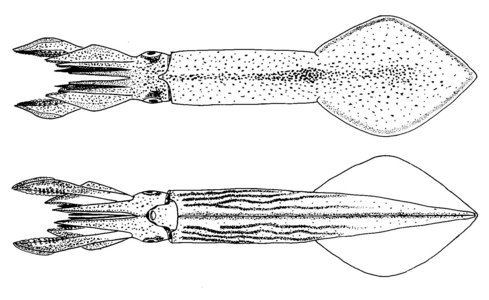Doryteuthis (Doryteuthis) plei
Slender inshore squid
Michael Vecchione and Richard E. YoungCharacteristics
- Mantle
- Mantle long, slender, cylindrical, the posterior end acutely pointed.
- Fins
- Fins rhomboid, their sides fairly straight.
- Gladius
- Gladius slender, feather-shaped.
- Ratio of greatest width of vane of gladius to greatest width of rachis 1.5 - 2.4.
- Edge of vane straight (often slightly curved in females), thick, and ribbed or rod-like (especially mature males)
- Buccal crown
- Suckers on ventral buccal lappets.
- Eyes
- Eye not unusually large; diameter of externally visible eyeball 14 - 19 % ML, diameter of dissected lens 2 - 7 % ML.
- Arms
- Left ventral arm hectocotylized in mature males by a modification of distal half to fourth of arm that extends to arm tip; one half to three fourths (42 - 82) of suckers in dorsal row much smaller than half the size of their ventral counterparts; modified (small) suckers on small, narrow, triangular pedicels.
Habitat and Biology
Occurs from the surface to 366 m depth, mostly shallower than 200 m; apparently concentrates near the bottom during the day and disperses into the water column at night, when it can be dip-netted at the surface. Matures over a broad range of sizes depending on season and locality: males 3.8 to 35 cm, females 4.2 to 20.3 cm mantle length, whereas they can remain immature up to 14 cm (males) and 9 cm (females); immature and mature specimens of a broad range or sizes maybe caught in the same net-haul. Gravid specimens are found the year round; all may not die after spawning. Feeds on crustaceans, small fishes, and probably squids.
Geographic Distribution
Western Atlantic, Gulf of Mexico, Caribbean Sea in con-tinental shelf and upper slope waters from Cape Hatteras, (very rarely to southern New England) to Fortaleza, Brazil; Bermuda, Bahamian and Caribbean Islands.
Other Names for Doryteuthis (Doryteuthis) plei
- Vernacular Names: En: Slender inshore squid, Fr: Calmar flèche, Sp: Calamar flecha
Title Illustrations

| Scientific Name | Doryteuthis (Doryteuthis) plei |
|---|---|
| Acknowledgements | Vecchione, M., C.F.E. Roper, and M.J. Sweeney. 1989. Marine flora and fauna of the eastern United States. Mollusca: Cephalopoda. NOAA Tech. Rep. NMFS 73:1-23. |
| Scientific Name | Doryteuthis plei |
|---|---|
| Specimen Condition | Live Specimen |
| View | Dorsal |
| Copyright | © 2005 Roger Hanlon |
About This Page
Michael Vecchione

National Museum of Natural History, Washington, D. C. , USA
Richard E. Young

University of Hawaii, Honolulu, HI, USA
Correspondence regarding this page should be directed to Michael Vecchione at
vecchioneM@si.edu
Page copyright © 2010
 Page: Tree of Life
Doryteuthis (Doryteuthis) plei . Slender inshore squid.
Authored by
Michael Vecchione and Richard E. Young.
The TEXT of this page is licensed under the
Creative Commons Attribution-NonCommercial License - Version 3.0. Note that images and other media
featured on this page are each governed by their own license, and they may or may not be available
for reuse. Click on an image or a media link to access the media data window, which provides the
relevant licensing information. For the general terms and conditions of ToL material reuse and
redistribution, please see the Tree of Life Copyright
Policies.
Page: Tree of Life
Doryteuthis (Doryteuthis) plei . Slender inshore squid.
Authored by
Michael Vecchione and Richard E. Young.
The TEXT of this page is licensed under the
Creative Commons Attribution-NonCommercial License - Version 3.0. Note that images and other media
featured on this page are each governed by their own license, and they may or may not be available
for reuse. Click on an image or a media link to access the media data window, which provides the
relevant licensing information. For the general terms and conditions of ToL material reuse and
redistribution, please see the Tree of Life Copyright
Policies.
- First online 02 September 2010
- Content changed 02 September 2010
Citing this page:
Vecchione, Michael and Richard E. Young. 2010. Doryteuthis (Doryteuthis) plei . Slender inshore squid. Version 02 September 2010 (under construction). http://tolweb.org/Doryteuthis_%28Doryteuthis%29_plei/52728/2010.09.02 in The Tree of Life Web Project, http://tolweb.org/










 Go to quick links
Go to quick search
Go to navigation for this section of the ToL site
Go to detailed links for the ToL site
Go to quick links
Go to quick search
Go to navigation for this section of the ToL site
Go to detailed links for the ToL site